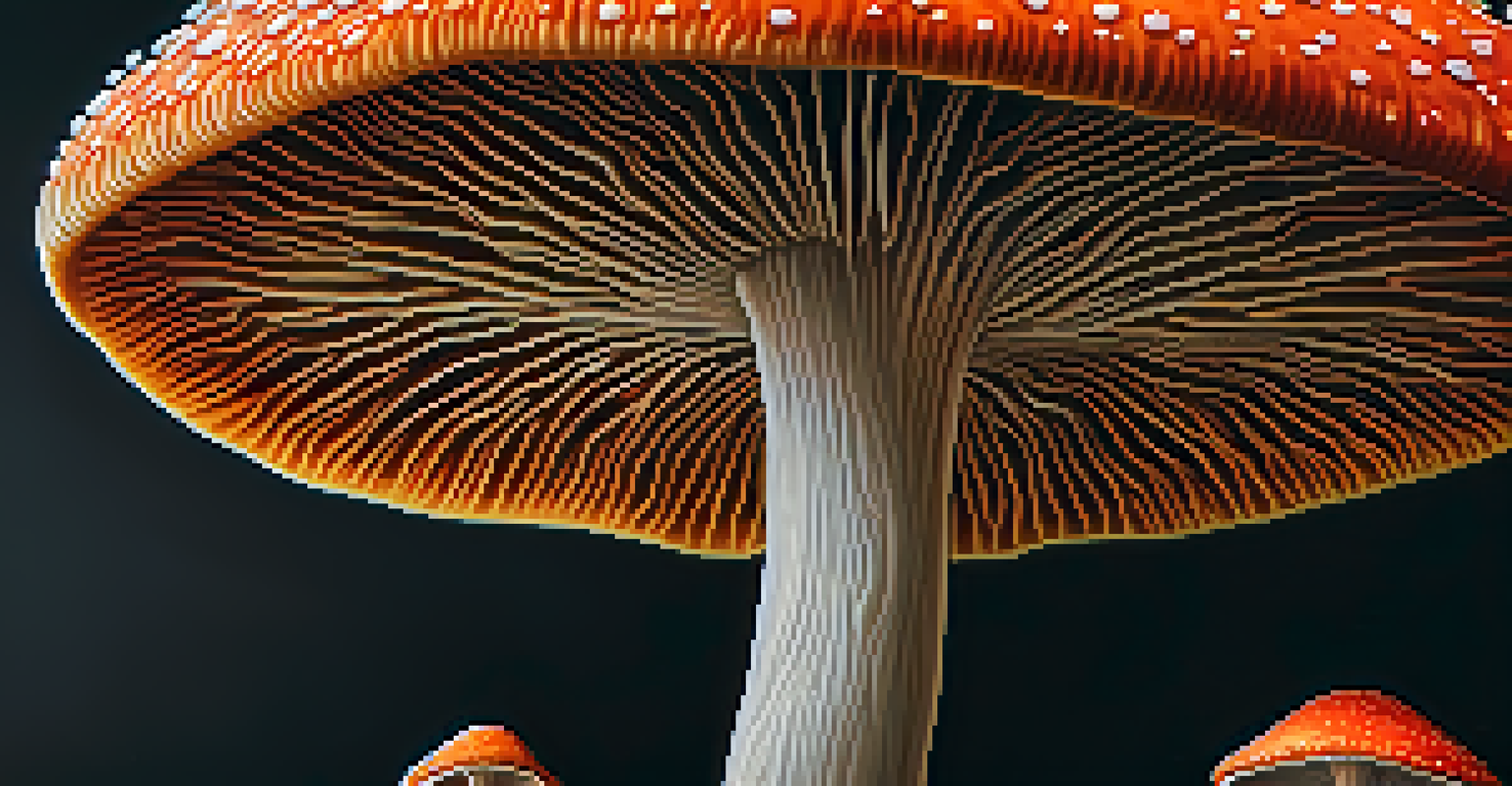The Interaction of Entheogens with Endocannabinoid Systems

Understanding Entheogens: A Brief Overview
Entheogens are substances that can alter perception, mood, and cognition, often used in spiritual or therapeutic contexts. Common examples include psilocybin (found in magic mushrooms) and ayahuasca, both revered for their profound effects on the mind and spirit. These substances have been utilized for centuries in various cultures, often in rituals aimed at enhancing spiritual experiences or promoting healing.
Psychedelics can help us heal trauma, understand ourselves better, and connect with others in ways we never thought possible.
In recent years, scientific interest in entheogens has surged, with researchers exploring their potential therapeutic benefits for conditions like depression and PTSD. This renewed focus is not just about the substances themselves but also how they interact with the body's complex systems, including the endocannabinoid system. Understanding these interactions can illuminate how entheogens might promote healing and well-being.
As we dive deeper, it's important to grasp how these substances work on a biochemical level, particularly their influence on neurotransmitters and receptors. By exploring these mechanisms, we can better appreciate the potential benefits and risks associated with entheogen use, setting the stage for a discussion about their interaction with the endocannabinoid system.
What is the Endocannabinoid System?
The endocannabinoid system (ECS) is a complex network of receptors and compounds that plays a vital role in maintaining homeostasis within the body. It consists of endocannabinoids, which are naturally produced by our bodies, and receptors (CB1 and CB2) that interact with these compounds. The ECS regulates various physiological processes, including mood, memory, appetite, and immune response, making it crucial for overall health.

When you consume cannabinoids, like those found in cannabis, they bind to the ECS receptors, leading to various effects on the body and mind. This interaction helps explain why cannabis can alleviate pain, reduce anxiety, or enhance appetite, depending on the individual and the context. Understanding the ECS is key to grasping how various substances, including entheogens, may influence our bodily functions.
Entheogens and Mental Health
Entheogens like psilocybin and MDMA show promise for treating mental health conditions such as depression and PTSD.
Recent studies suggest that the ECS might also play a role in how entheogens exert their effects. As we explore the intricacies of these interactions, we can uncover how altering ECS activity through entheogens may lead to unique psychological experiences and potential therapeutic outcomes.
The Link Between Entheogens and the ECS
Entheogens and the endocannabinoid system are more interconnected than one might initially think. Research indicates that certain entheogens may interact with the ECS by influencing endocannabinoid levels or directly binding to cannabinoid receptors. This interaction could enhance the psychoactive effects of entheogens, leading to deeper and more profound experiences.
The endocannabinoid system is a master regulator of homeostasis, influencing our emotional and physical health.
For instance, psilocybin is known to affect serotonin receptors, but emerging studies suggest it may also modulate endocannabinoid signaling. This dual action could amplify the therapeutic benefits of psilocybin, particularly in treating mood disorders. By understanding this relationship, we can gain insights into the potential of entheogens as holistic treatment options.
Additionally, the ECS's role in modulating stress and anxiety responses could explain why some individuals report feelings of relief or euphoria after using entheogens. These substances may not only alter consciousness but also help rebalance the ECS, suggesting a fascinating synergy that warrants further exploration.
Potential Therapeutic Uses of Entheogens
The therapeutic potential of entheogens, particularly in conjunction with the ECS, is a growing area of interest in modern medicine. Research has shown that substances like psilocybin and MDMA have significant potential in treating various mental health conditions, such as depression, PTSD, and anxiety. Their ability to induce altered states of consciousness may provide patients with new perspectives on their trauma or mental health challenges.
Moreover, the ECS’s role in regulating mood and emotional responses makes it a prime candidate for further study in conjunction with entheogens. For example, the modulation of endocannabinoid levels might enhance the emotional processing that occurs during psychedelic experiences, potentially leading to more effective therapeutic outcomes. This synergy highlights the need for a holistic approach to treatment that considers both the psychological and physiological aspects of healing.
Role of the Endocannabinoid System
The endocannabinoid system is crucial in regulating mood and emotional responses, potentially influencing the effects of entheogens.
As more clinical trials emerge, we are beginning to see promising results that suggest the combination of entheogens and ECS modulation could revolutionize mental health treatment. However, it's essential to approach this field with caution and respect, ensuring that research is conducted ethically and with an understanding of the complexities involved.
Risks and Considerations When Using Entheogens
While the potential benefits of entheogens are exciting, it's crucial to recognize the risks and considerations involved in their use. Not everyone reacts the same way to these substances; some individuals may experience adverse effects, including anxiety, paranoia, or challenging psychological experiences. Understanding one's mental health history and the setting in which these substances are used is vital to minimizing risks.
Moreover, the interaction between entheogens and the ECS is still being understood, and it’s essential to consider how these substances may affect different individuals. Factors such as dosage, individual biochemistry, and prior experiences with psychedelics can all influence the outcomes. Therefore, an informed and cautious approach is necessary to ensure safety and well-being.
Education and preparation play critical roles in responsible entheogen use. Whether it’s participating in guided sessions or thoroughly researching the substances, being informed can make all the difference in having a beneficial experience. Recognizing the potential risks helps create a safer environment for exploring the transformative possibilities of entheogens.
The Future of Entheogens and the ECS
As interest in entheogens continues to grow, so does the need for rigorous scientific research to understand their interactions with the endocannabinoid system. The potential for these substances to contribute to mental health and well-being presents a unique opportunity for advancements in both science and therapy. Ongoing studies will help clarify how entheogens can be used safely and effectively.
The future may hold exciting possibilities, including the development of new treatment protocols that incorporate entheogens alongside traditional therapies. Imagine a world where mental health care is enhanced by these natural substances, offering patients a broader array of options for healing. This integration could lead to more personalized approaches to treatment, catering to individual needs and preferences.
Risks of Entheogen Use
While entheogens can offer transformative experiences, they also carry risks, including adverse psychological reactions that necessitate caution.
However, as we advance, it's crucial to maintain a balanced perspective that respects the cultural and historical significance of these substances. Ensuring that research and applications are conducted ethically will be vital in shaping the future landscape of entheogen use and its relationship with the ECS.
Conclusion: A Journey into Healing
The exploration of entheogens and their interaction with the endocannabinoid system opens up a fascinating dialogue about healing and consciousness. As we uncover the complexities of how these substances work within our bodies, we gain valuable insights into their potential benefits and risks. This journey encourages us to consider the broader implications of integrating natural substances into our understanding of health and wellness.
While the scientific community continues to investigate the therapeutic potential of entheogens, individuals can also engage in dialogues about their experiences and insights. Sharing personal stories can foster a deeper understanding of the diverse ways in which these substances can impact our lives, both positively and negatively. This collective sharing enriches our knowledge and helps create a more informed community.

Ultimately, the intersection of entheogens and the endocannabinoid system invites us to rethink our approaches to mental health and healing. By embracing curiosity and respect for these powerful substances, we can navigate this evolving landscape with openness, ensuring that we honor both the science and the stories behind entheogens.